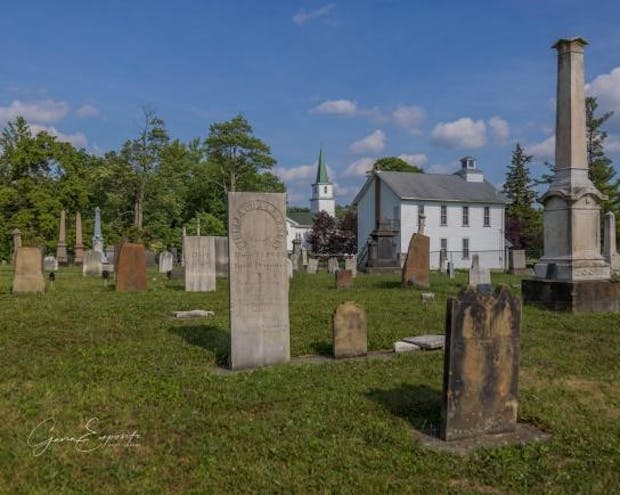Vienna Memorial Cemetery
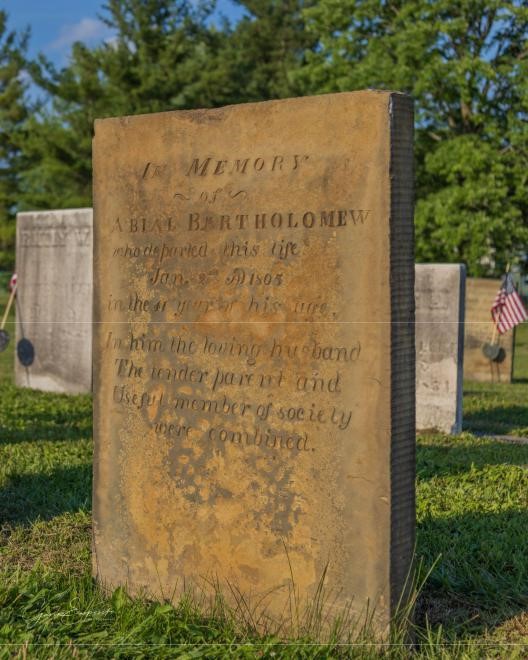
Tucked behind the quaint New England-style village green of Vienna Center is the Vienna Memorial Cemetery. Informally established in 1805 upon the township’s first death, that of Abiel Bartholomew, a native of Waterbury, Connecticut, Bartholomew was killed while felling a tree with his son, Ira on January 4th of that year. In the winter following his death, a deed for the village green, as well as the corresponding land that the grave sat on was issued. However, it wasn’t until June 20, 1810, that the deed would be officially recorded by the Trumbull County Recorder’s Office. Given to the township by Connecticut Land Company proprietors Ephraim Root and Urial Holmes, the future home of the Vienna Memorial Cemetery was described in the document as “eight acres” of “cleared and improved land North and West of the Centre Point'.” Purchased by the Presbyterian Society, a non-religious, business-minded branch of the local Presbyterian Church for $20, the tract was soon divided up with six acres going to the Society, while two of the southernmost tracts surrounding Abiel’s grave formed the basis of the Memorial Cemetery.
The headstone of Abiel Bartholomew, the first in the Vienna Memorial Cemetery
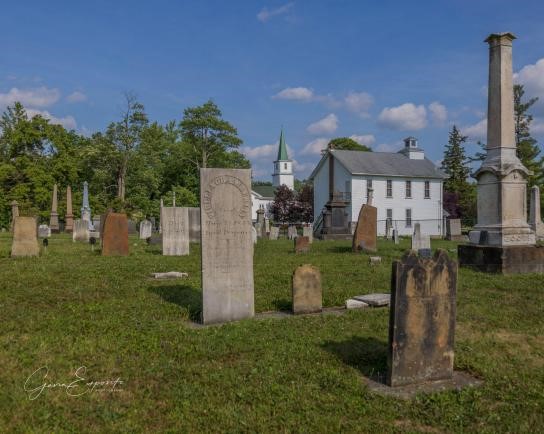 Faithfully serving as a resting place for Vienna Township’s dead for over 130 years, the original cemetery, or what is now known as the “Old Section” was closed to any new interments in 1938 with the addition of “Section 1” to the north. Giving the cemetery an additional 216 plots for use, it is this tract that is still in public use today. However, for this article, we will be looking at the Old Section, which naturally contains the remains of many of Vienna Township’s historical residents. To easily find the graves featured in this presentation, markers are listed in order of appearance as one walks through the cemetery, starting at the front gate, as well as photographs for easy identification.
Faithfully serving as a resting place for Vienna Township’s dead for over 130 years, the original cemetery, or what is now known as the “Old Section” was closed to any new interments in 1938 with the addition of “Section 1” to the north. Giving the cemetery an additional 216 plots for use, it is this tract that is still in public use today. However, for this article, we will be looking at the Old Section, which naturally contains the remains of many of Vienna Township’s historical residents. To easily find the graves featured in this presentation, markers are listed in order of appearance as one walks through the cemetery, starting at the front gate, as well as photographs for easy identification.
A view of the Vienna Memorial Cemetery looking towards the green. The steeple of the Presbyterian Church can be seen in the distance.
Mary “Polly” Bartholomew: Portrait of the Past
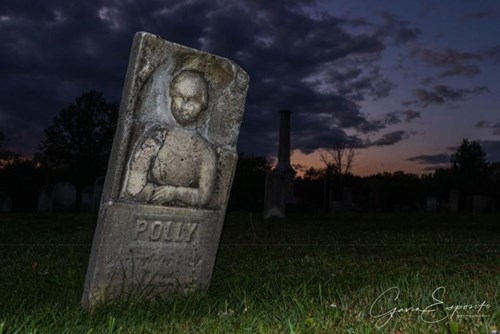
Born in 1849 to Eli and Minerva Bartholomew as the third out of seven children, Polly’s great-grandfather was Abiel Bartholomew, as mentioned before, a former native of Waterbury, Hartford County, Connecticut who in 1805, became the first person to be buried in what is now the Vienna Memorial Cemetery. Sadly, details on Polly’s life are scarce, as, in late 1860, she passed away at the age of 11 during an epidemic of “putrid sore throat,” or what would be referred to in modern terms as diphtheria. Greatly mourned by her dear parents, they had a headstone made in her likeness by an unknown carver; featuring a rare bas-relief portrait made of their daughter set in the marker. To this day, Polly lives on in the form of limestone, viewing those who pass by her grave with an air of childlike curiosity.
With her arms daintily crossed and eyes fixed in an eternal gaze over the rest of the Vienna Memorial Cemetery, the limestone formations of Mary “Polly” Bartholomew rests against the backdrop of an October twilight.
Lambert W. Lewis: Village Clockmaker
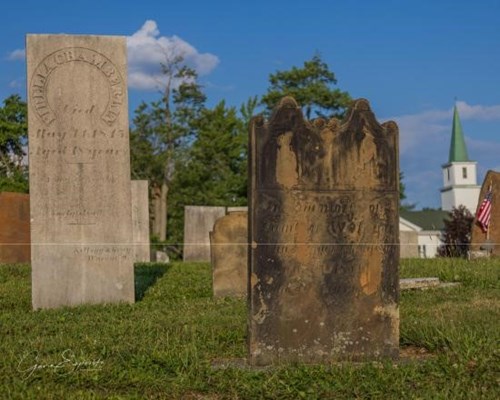
From roughly 1812 until 1835, Trumbull County was home to a unique industry: clockmaking. During this 23-year period, over 75,000 tall cased wooden wheeled (grandfather) clocks were manufactured in Vienna, Brookfield, Hartford, Howland, and Warren townships. Exported either back to New England or to New Orleans; this is largely considered to be the county’s first foray into the world of manufacturing. Among this area's clockmakers, many of whom hailed from Western Connecticut, was Lambert W. Lewis, formerly of Southbury, New Haven County. Likely acquainted with the trade back east, Lewis settled at Vienna in 1806 and purchased a tract of land along the south side of Warren-Sharon Road across from what is now Crown Hill Burial Park, this land, in time, would become the site of his clock factory. Marrying Lois Sanford in 1809, by 1811, he was listed as a founding stockholder in the Bank of the Western Reserve, the first monetary institution to exist in Northeast Ohio. Serving as a private during the War of 1812 in Capt. Asa Hutchins’ Company under the Hayes Regiment of the Ohio Militia from August 24th until November 11th of that year.
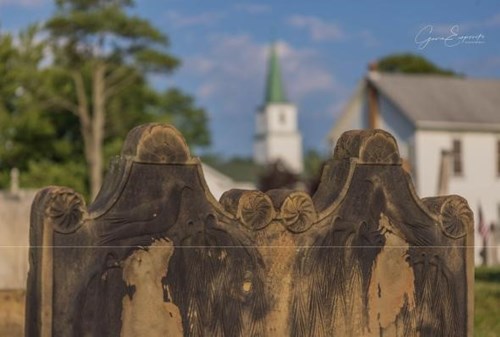
Lewis’s headstone at the Vienna Cemetery. An accompanying footstone, marked with his initials L.W.L. can be seen behind the main marker
In 1815, Lewis officially entered the clock-making business when he erected a three-and-a-half-story factory on the lot he purchased for this purpose in 1806. Powered by a branch of Squaw Creek, the structure eventually became the largest, and longest-running clock factory in Trumbull County; exclusively focused on the production of 30-hour tall case clocks signed on the face with “L. W. Lewis.” In operation, until the clock-making industry in Trumbull County began to decline in the early 1830s due to a combination of economic depression and shoddy workmanship, Lewis frequently found himself fighting lawsuits and in debt towards the end of his life. Passing away on August 16th, 1834 at the relatively young age of 48 years after what was described as a “very short and painful illness” in the Western Reserve Chronicle’s obituary section, he was interred at the Vienna Cemetery under a double brownstone marker featuring two weeping willows for each side, plus doves perched atop them—a motif rarely seen in gravestone iconography.
Forever confined in stone, never to soar through the air, the chiseled form of two mourning doves top the headstone of clockmaker Lambert W. Lewis, silently mourning for eternity
Rev. Nathan Bailey Derrow: The Good Reverend
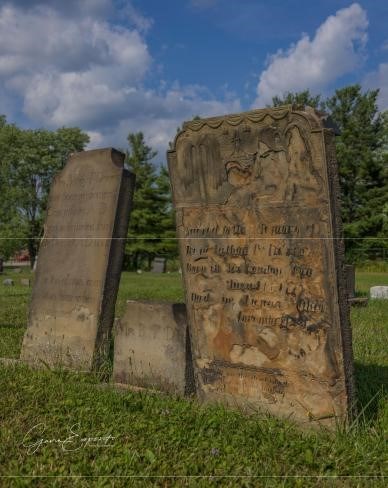
The first “regular” pastor of the Vienna Presbyterian Church, Nathan Bailey Derrow was born in New London, New London County, Connecticut on August 16th, 1773. Relocating to western New York to study theology at the Hamilton College in Clinton around 1800, he was licensed by the Oneida Association to become a pastor in 1801, and a year later was ordained to preside over a “home church” at nearby Homer, New York. Perhaps recruited by the Connecticut Missionary Society, a branch of the Congregational Church that between 1798 and 1821, sent missionaries to provide religious instruction among the frontier towns of Ohio, Pennsylvania, New York, and Vermont. In 1807, Derrow left New York and came to Vienna Township. Using Vienna as somewhat of a “home base,” Derrow traveled throughout the Western Reserve establishing churches in other communities, notably in Aurora, Geauga County, and Painesville, Lake County. Returning to Vienna a year later in 1808, just three years later in 1811, he was installed as the first permanent pastor of the Vienna Presbyterian Church, succeeding the itinerant Rev. Thomas Robbins who had established the congregation and returned to Connecticut that year.
Nathan (right) and Betsey (left) Derrow’s headstones. Although badly chipped and weathering away, with a keen set of eyes, one can discern the inscription on Nathan’s headstone as follows: “Sacred to the memory of Rev. Nathan B. Derrow, born New London, Conn., August 11th, 1773, Died in Vienna, Ohio, November 16th, 1828.”
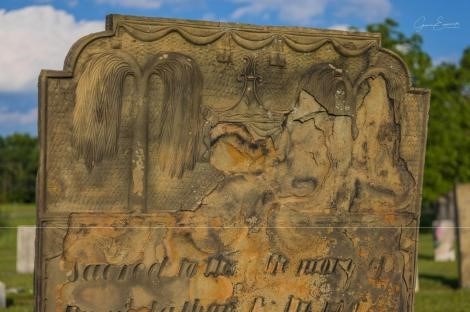 While holding what would be his first pastorate over the Presbyterian Church in 1816, the Connecticut Missionary Society offered Derrow an appointment out west in the Indiana Territory. Traveling down to the Ohio River and crossing at Louisville, Kentucky he proceeded to Fort Harrison north of Terre Haute, Indiana. Upon arrival, he was met by a growing population served by eager but illiterate preachers, and due to his educated background, was often the only source of literacy in these parts. Known to read for the local population when books were available, he organized two churches west of Terre Haute, the first along the Indiana-Illinois Territory line on the banks of the Wabash River in the fall of 1817, and the second at Golconda, Illinois in 1818, which would become the oldest Presbyterian church in Illinois. By 1819, his work was complete, and he returned to Ohio shortly after, settling back in Vienna. On December 20th, 1820, Nathan married, first to Betsey Fobes of Wayne Township, Ashtabula County, however within two years, he had been left a widower by her sudden death. On September 23rd, 1823, he married a second time, to Laura Loomis, with whom he had one daughter; named Esther. Resuming his tenure as pastor of the Vienna Presbyterian Church in 1825, he held this position until his death in 1828 at the age of 55. Buried next to his first wife, Betsey, his grave is topped with a brownstone marker adorned by the carvings of two weeping willows. and an urn, sadly due to the ravages of time, becoming badly worn almost to ruin.
While holding what would be his first pastorate over the Presbyterian Church in 1816, the Connecticut Missionary Society offered Derrow an appointment out west in the Indiana Territory. Traveling down to the Ohio River and crossing at Louisville, Kentucky he proceeded to Fort Harrison north of Terre Haute, Indiana. Upon arrival, he was met by a growing population served by eager but illiterate preachers, and due to his educated background, was often the only source of literacy in these parts. Known to read for the local population when books were available, he organized two churches west of Terre Haute, the first along the Indiana-Illinois Territory line on the banks of the Wabash River in the fall of 1817, and the second at Golconda, Illinois in 1818, which would become the oldest Presbyterian church in Illinois. By 1819, his work was complete, and he returned to Ohio shortly after, settling back in Vienna. On December 20th, 1820, Nathan married, first to Betsey Fobes of Wayne Township, Ashtabula County, however within two years, he had been left a widower by her sudden death. On September 23rd, 1823, he married a second time, to Laura Loomis, with whom he had one daughter; named Esther. Resuming his tenure as pastor of the Vienna Presbyterian Church in 1825, he held this position until his death in 1828 at the age of 55. Buried next to his first wife, Betsey, his grave is topped with a brownstone marker adorned by the carvings of two weeping willows. and an urn, sadly due to the ravages of time, becoming badly worn almost to ruin.
Once rich with ornate detail, the form of two weeping willows and an urn now lie decaying atop Nathan Derrow’s headstone.
Cordelia Baldwin: An Unknown Headstone Carvers Legacy
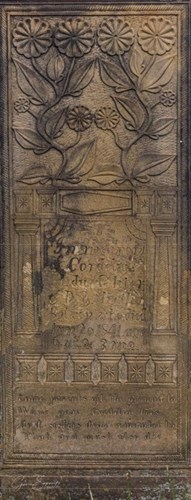
Adorned with blooming flowers, leaves, matching columns, and a coffin laid horizontally, the headstone of little Cordelia Baldwin is a sight to behold. The firstborn daughter of Decius and Arathusa Hurlbert Baldwin, formerly of Simsbury, Hartford County, Connecticut, Cordelia died on January 25th, 1841, at the tender age of five years old. However, her headstone is one fit for a queen. Although the identity of the carver is unknown, he does have a moniker:” Fancy D,” a name taken from the fanciful, swooping “D’s” that he incorporated into the words “died,” “deceased,” and the like. Choosing to carve in sandstone and occasionally dabbling in limestone, D favored naturalistic motifs such as broad oak leaves, vines, flowers, acorns, and of course the ever-so-popular willow coupled with an urn.
Embellished with flowers, leaves, geometric shapes, and even a coffin, the headstone for Cordelia Baldwin is one of, if not the most ornate headstones at the Vienna Memorial Cemetery
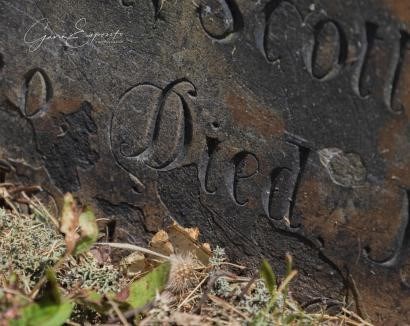
In addition to these, he also included geometric embellishments such as fans, diamonds, and perhaps his most recognizable symbol; a six-sided coffin laid horizontally somewhere on the stone, usually either above or below the inscription. With over 25 markers found throughout the Southern Tier of New York dating from 1822 through 1836 and 50 some in the Northeast Ohio counties of Ashtabula, Trumbull, Mahoning, and Portage as well as the adjoining Pennsylvania counties of Lawrence and Crawford dating from 1832 through 1842; the existence of concurrent dates in both New York and Ohio suggests that “D” lived in one area and exported markers as need be, a relativity common practice at the time. Although Fancy D's identity remains anonymous and will likely remain so for years to come, his contribution to the countless cemeteries in the area remains noted, including over the grave of little Cordelia Baldwin.
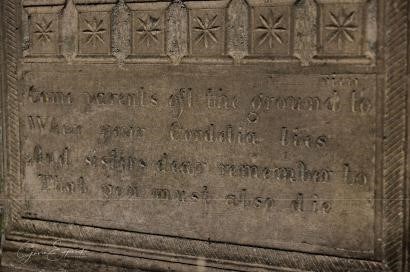
While the word “died” has long since been worn off on Cordelia’s headstone, this photo of another marker by Fancy D at the East Gustavus Cemetery 20 minutes north of Vienna gives us a good idea of where he acquired the moniker from.
Harkening back to an era when child mortality was common, the epitaph on Cordelia’s grave warns both her parents and sisters that they also will die someday with the following verses: “Come parents oft the ground to view where your Cordelia lies, and sisters rememebre to that must also die
